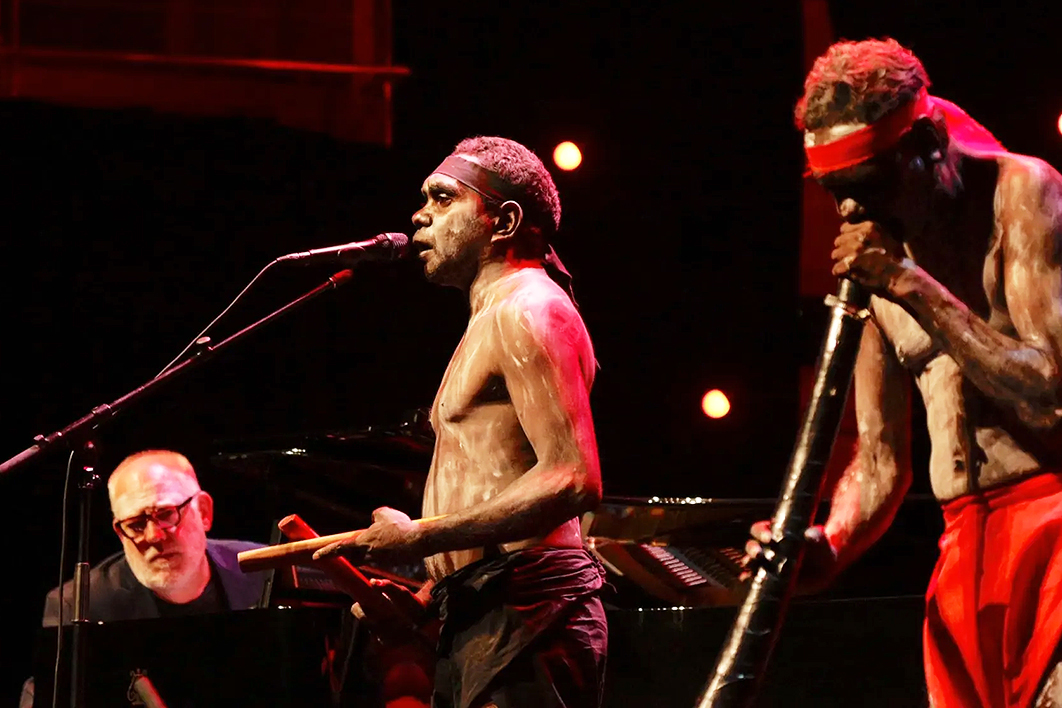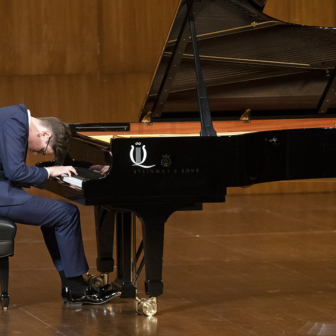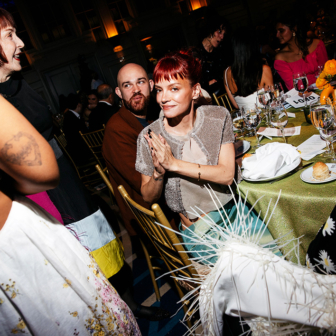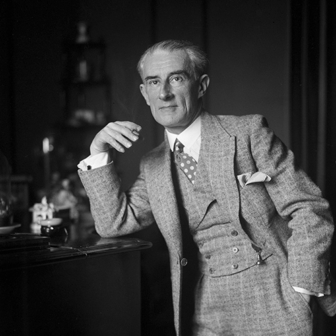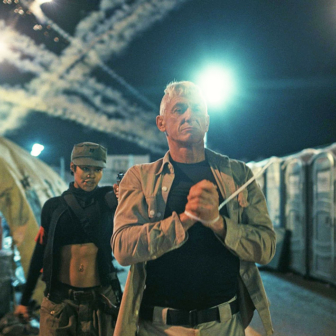The composer, pianist and bandleader Paul Grabowsky has always been inquisitive and open. Not only has he worked with many of the world’s great jazz musicians, he has also composed symphonic and operatic works. But it is his collaborations with artists from outside the jazz and classical spheres that have come to define him, and his work with First Nations artists that he considers his most important.
ANDREW FORD: You once told me the piano was the centre of your musical universe. This suggests that being alone at the piano is where everything starts. Does it?
PAUL GRABOWSKY: Every musician would regard their instrument as the centre of their musical universe, but there’s an additional philosophical proposition behind that to do with what the actual relationship is between playing music and life more generally. What I’ve said many times over the years is “the piano never lies,” by which I mean that the piano, as beautiful as it is, is ultimately a large, complicated piece of essentially nineteenth-century technology, utterly mute, even useless, until it becomes the means of expression for a player. It will quickly reveal to the player where they are at, no quarter given. So that’s been my relationship with the piano: my lover, my scold. Does everything start there? Yes, because my musical language was developed at the piano, and informs everything I make, whether orchestral music, which has lately taken up a lot of my time, or anything else, down to solo piano music per se.
AF: During the pandemic, there were two things I genuinely looked forward to. One was Tim Stevens’s daily “quarantune,” the other your Friday night offering from the piano — and it was an offering, a sharing, a weekly gift. What did you get out of that?
PG: The lockdowns were famously severe in Melbourne. Our communal patience was tested to its limits. There were no gigs for quite a while, but luckily we had the ability to communicate via other means. I’ve long harboured the belief that music is forged out of the mysterious moment of exchange between player and listener; that until that exchange occurs there is no “music,” just latency, intent. To be able to play on those Fridays gave me something to look forward to, a virtual happy hour, which we would prepare for in the home with nice food and drinks, to create a sense of occasion. I did it for the sake of my own morale initially. Just before the first wave of Covid really hit, I had heart surgery, so I was convalescing, and the playing helped greatly. It was only later that I started to realise that a lot more people were listening in than I’d realised, and from all over the place. Now I know that it helped other people find their Fridays, locate themselves within the temporal wasteland, join in the occasion, and I am deeply grateful to have been able to make even a small difference.
AF: You’ve been a collaborator from the start — in trios, leading bands, working with singers — but some of your most surprising and memorable collaborators have been from outside jazz. Do you suddenly think, “This might work”? And how do you know?
PG: I think the word “jazz” has been something of a shibboleth for me. I deeply love the music, and still regard it as describing some of the greatest art produced in the twentieth century, but I’ve felt more drawn to the processes that arrive at certain outcomes than the notes that define what we might call “style.” This was the philosophy behind the Australian Art Orchestra from its beginnings in the early 1990s, that collaborations involving the creative application of improvisatory paradigms, including (but not exclusively) jazz, could lead to fascinating and meaningful outcomes.
A lot of the thinking here has been influenced by my love for the art of Ornette Coleman, where what he called “harmolodics” — and I call “relationality” — is the driving principle of both the music and everything that informs it. This thinking inspired early AAO projects (Ringing the Bell Backwards, Passion, Into the Fire, Sita) and then found its most satisfying outcomes in collaborations with Uncle Archie Roach and Aunty Ruby Hunter (Ruby), and with the Young Wägiluk Group (Crossing Roper Bar). So it has been relatively straightforward to apply this idea of relationality to one-on-one projects with singers (Vince Jones, Kate Ceberano, Paul Kelly, Emma Donovan, Ngaiire, Joe Camilleri, etc.), as I come to them with an open mind, not trying to impose “jazz” onto their songs, but simply to make music together.
AF: The collaboration that has persisted longest is the deep engagement you and other improvising colleagues have had with the songmen of Ngukurr in Southeast Arnhem Land, which I think started with Crossing Roper Bar. How did that come about?
PG: For years I wanted to connect with the oldest musical tradition on the planet. It confused me that Australians were quick to see the unique qualities of the visual art of our First Peoples, even adorning our passenger jets with their designs, but seemed oblivious to their music, other than perhaps knowing what a didgeridoo looks like. Of course it’s not easy to have access to language and culture-based First Australians; the locations are often difficult to get to, and just being there isn’t necessarily going to get you very far. I have a friend, Steve Teakle, who was working with various remote communities in the Territory at the time, and he took me to Ngukkur on the Roper River in Southeast Arnhem Land, as he felt sure that the ceremonial songmen there would be happy to talk. Within minutes of arriving there I met Benjamin and Roy Wilfred, and they were singing the Djawulparra manikay (song cycles) to me. It was utterly overwhelming. Nothing had prepared me for the sheer visceral power of this music. That was in 2004 and I haven’t stopped loving the music and its makers and regarding them as one of the world’s great artistic treasures.
AF: You’ve worked with Daniel and David Wilfred on a number of projects. How do you work together?
PG: The willingness of the Wilfreds to collaborate was there right from the beginning, but it took me years to understand the reasons why these collaborations were second nature to them. It had to do with a belief system that expresses the interconnectedness of all things, including time and space, and that these manikay are expressions of that interconnectedness, that everything that happens within the ceremonial framework of the manikay is the manikay, not some form of provocation. The generous spirit of sharing, of commonality of being, that lies at the heart of this form is the gift we have been offered by our First Peoples since colonisation began, but the colonisers have largely chosen to ignore it.
The latest iteration of the relationship is a project called Raki. This word means several things, including the “bush string” used to make dilly-bags for food; it also signifies “law” in the sense of being the string that binds people together, and conveys knowledge and protection across country and between different peoples. Daniel Wilfred leads the project, together with Peter Knight on trumpet and electronics and me on piano. Daniel explains the significance of the word, and conveys the rhythmic modes played on the bilma (clapsticks). I have to perform some of the yidaki (didgeridoo) functions, and he is very insistent that this is done with the necessary degree of intensity and accuracy. In manikay the yidaki functions as a drum, not as a drone, which is the way it is played in some contemporary practice. The yidaki rhythmic patterns in manikay are very complex, and tightly related to the melodies.
The music follows the start/stop form of manikay: tight bursts of great intensity, followed by what Daniel would call “head song,” which takes the form of a spacious improvisation that often invokes locations and ancestors, roaming through space and time and allowing for freewheeling interaction across the trio until the commencement of the next section.
AF: You mentioned visual art before. There have been some objections in non-Indigenous visual art circles about “traditional” art by First Nations artists turning up in “contemporary” shows. I imagine that to you, as a collaborating musician, such a distinction is moot, but I wonder if you think about it at all — I mean from a philosophical point of view? Wynton Marsalis once insisted that all jazz is contemporary because it’s made in the present and never the same twice. Is it the same with all traditional music?
PG: It seems to me the critique around “traditional” versus “contemporary” when it comes to art is a furphy when we’re talking about the world’s oldest living culture. Was Emily Kngwarreye a “traditional” artist? Rover Thomas? Surely not in a precolonial sense. These ancient practices adjust to changing times and conditions without the teleological overlay of “modernism” playing any role. The same is true of manikay. Songs can be about ancestor creator-figures, but can equally be about smoking, drinking and going fishing (in a powered vessel).
Blues music makes a reasonable point of comparison. When was it ever “traditional”? We use the same term applied to New Orleans–style jazz, too, and this is I guess what Wynton means about all jazz being “contemporary.” My projects with the Wilfreds don’t comply with any need to justify their contemporaneity, as they express a timeless belief system within a contemporary collaborative paradigm.
AF: What do you gain from this collaboration as a musician and — if you can make such a distinction — personally?
PG: As suggested above, my work with First Peoples has been quite literally life-changing. I mentioned the influence of Ornette Coleman’s harmolodics to my understanding of musical processes, and this idea of relationality has been clearly revealed to me in the practice of manikay and more generally in my interactions with the Wilfreds. I must add that my work with Uncle Archie Roach was equally profound, and that the generosity of spirit of which manikay is such an eloquent expression was also evident in every word, sung or spoken, by the great Uncle Archie Roach and by Aunty Ruby Hunter.
This is my lived experience of working with our First Peoples, and I wish that every Australian could share in that love. This is why the Voice means so much to me. We as a nation have not listened to our First Peoples, and their right to an advisory body collecting information and making it readily available to governments as they come and go should be enshrined in, and protected by, our Constitution.
AF: This might be hard to answer, but what do you think you offer someone like Daniel Wilfred? Do you think you’ve changed him musically?
PG: It’s not that hard to answer. Like every great artist, Daniel sees possibilities arising out of collaborations that may not have otherwise occurred to him. He sometimes says that his grandfather, the great songman and painter Djambu Barra Barra, comes to him in dreams and gives him new songs. He introduces these into projects like Raki or the work he has done with Peter Knight’s Hand to Earth project.
Manikay is a living, dynamic art form, and while its roots lead deep into the well of time, it remains vibrant, new and exciting in many projects emerging in contemporary Australia. I don’t expect Daniel to gradually reinvent himself as another type of singer, but I do know that he is contributing to the ongoing relevance of the world’s oldest form of song. •
